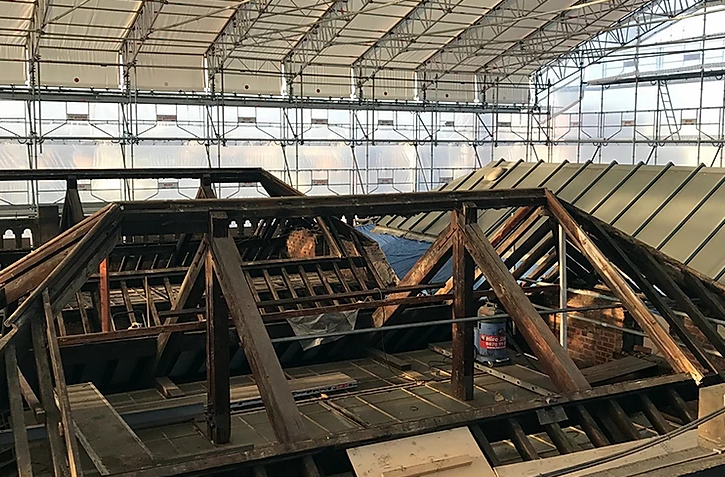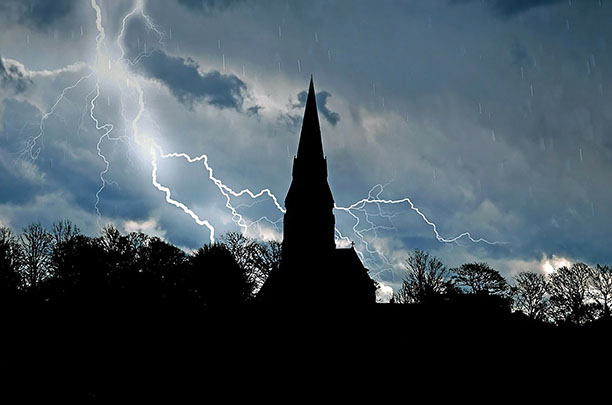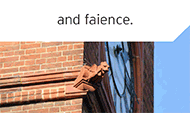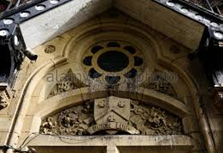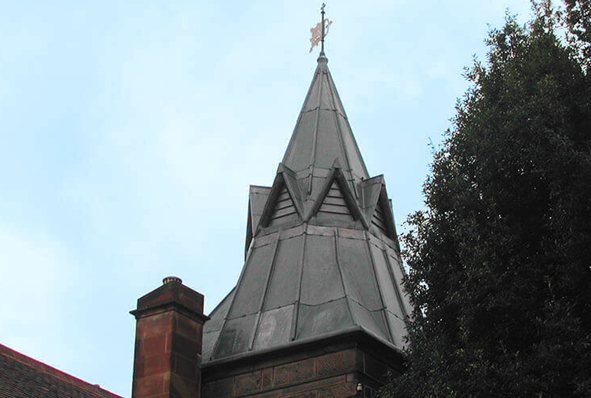Heritage Roofing
Heritage roofing - maintaining our iconic buildings
The UK is home to some of the most iconic buildings in the world, from stunning churches and cathedrals to historic stately homes. Each and every one of these remarkable feats of architecture requires regular maintenance to ensure they remain in the very best condition, allowing them to be enjoyed for generations.
Cathedral Care
Restoration and upkeep of cathedrals
There are some 42 Anglican cathedrals in the UK, not to mention 20 or so Catholic cathedrals. Cathedrals form the most important collection of historic buildings in England. The largest and most ancient are internationally famous, the smallest are usually among the most significant buildings in their region and even the most recent are architectural masterpieces.
Master Craftsmen
Championing our heritage with modern craftsmanship
Twenty years ago, English Heritage (now Historic England) published its first-ever Register of Buildings at Risk across England, which featured nearly 2,000 buildings and monuments that were ‘neglected, broken and unloved’. Recently Historic England was delighted to announce that over two-thirds of those buildings were now safe, in both urban and rural areas right across the country.
Lightning Protection
When lightning strikes are you protected against this act of God?
The issue of lightning protection in churches is one that has exercised this publication for many years. In this four-part series of spotlights on the issue we will be revisiting various aspects of the subject, beginning with an overview of current thinking.
Traditional Lime
Lime: it’s better for buildings – and for the environment
It is now fairly well known that cement is not good for old buildings and that lime mortar should be used. But why? What are the advantages and what are the disadvantages? In order to begin to answer those questions it is necessary to understand the nature of traditional building, the process by which buildings used to be built, and how it differs from modern construction, the process by which we build today.
Audio Visual
Audio visual equipment in church buildings
This guidance is issued by the Church Buildings Council under section 55(1)(d) of the Dioceses, Mission and Pastoral Measure 2007. As it is statutory guidance, it must be considered with great care. The standards of good practice set out in the guidance should not be departed from unless the departure is justified by reasons that are spelled out clearly, logically and convincingly.
Read More...
CRE Events
All change at CRE: the UK’s ‘ideal church show’
The Christian Resources Exhibition (CRE), the UK’s largest church-related show, has changed hands in its 40th year and has been taken over by Quartz Business Media.
Insurance
You need to ensure that reasonable precautions are in place at your church to keep it safe for those who use it. To do this, you need to think about what might cause harm to people.
You will then need to decide if the precautions already in place are adequate. If they are not, you may need to identify further action to prevent any danger. When done formally, this is known as a risk assessment.
LPOW Grants
£23 million government package to support restoration of thousands of listed places of worship
Heritage Minister Sir Chris Bryant has announced that the Listed Places of Worship Grant Scheme will be extended into the next financial year, providing £23 million so that thousands of historical buildings, including churches, synagogues, mosques and temples, can carry out restoration work.
Church Maintenance
Church maintenance and repair: Calendar of Care
Just as prevention is always better than cure, maintenance is preferable to major repairs. But, such repairs may not always be avoidable. Church Care offers a monthly guide in our coming issues Starting in Spring
We can help you understand the common problems and areas that need your special attention, and give you tips for regular maintenance schemes.
Pest Control
Michael Palin warns of pest threat to churches
Michael Palin is supporting the future of the UK’s historic churches and chapels with a voiceover for a new animated film. The 80 second animation, produced for the National Churches Trust, highlights why churches are some of the nation’s best loved buildings.
Town Halls
The history of the great Victorian Town Halls of Northern England
From industrial squalor to civic pride, the story behind some of the most impressive buildings of the North involve a unique mix of economics, grand designs and noble sentiments within communities.
Lead Roofing
Lead is one of the oldest materials in the roofing industry and is still commonly used throughout the world today.
Lead roofing is a traditional roofing method which has been used in the industry for hundreds of years, and is therefore proven to be extremely reliable. Lead roofing, and sand-cast lead, in particular is ideal for old buildings such as churches or historical renovations, whereas milled lead roofing is a mass-produced alternative, used for precision and accuracy in homes and commercial buildings alike.
SEARCH OUR DIRECTORY
LCA - the art of lead is not dead!
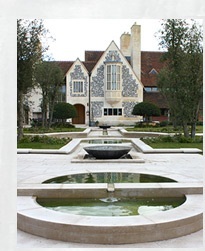 At the LCA they never cease to be amazed at the skills and creative ingenuity of their members. Those that consider leadworkers as 'just another roofing trade' should look closely at the photographs below and perhaps think again.
At the LCA they never cease to be amazed at the skills and creative ingenuity of their members. Those that consider leadworkers as 'just another roofing trade' should look closely at the photographs below and perhaps think again.
Water features in lead are not that unusual with various styles of fountain head decorated by cast cherubs, birds, fish, etc often featuring in the bespoke catalogues of those that focus on the more decorative side of the craft.
However the sheer scale of the chalices tackled by Brian Turner of Turner’s Ornamental Leadwork was in itself hugely impressive and when considering the finished item in the final photographs shown here, one can only wonder “how on Earth did he do that?”
The requirement from the client was for two lead chalices each made of an internal and external bowl, shaped and then lead welded together to form a water feature at his large country house.
Straightforward enough perhaps, until you look at a few dimensions:
Finished diameter - 1.5M (starting from a diameter of 1.7M)
Thickness - 50mm (centre) tapering to 10mm at the edge
Weight - 905 kgs (the second chalice was ‘only’ 825kgs)
Finish - Planish (hammered effect)
To address the handling logistics Brian first built his own turntable from steel and plywood.
The basic pattern shape was a 1400mm diameter panel with two cords cut off to allow for sand casting. The centrepiece casting was a plate 300mm diameter, 50mm thick, with further plates of 25mm and 10mm then welded around the circumference.

The two cord sections were then sand cast and lead welded into place. Brian then sand cast further plates in curved section 150mm wide by 10mm thick which he welded to the outside circumference of the centre plate to form a complete circle of solid lead 1.7M in diameter.
Using firstly a large rubber mallet and then specially adapted metal club hammers to boss the lead (unusually) inwards.

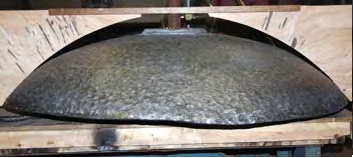

Brian worked the lead from the outer edge towards the centre, at the same time shaping the circle downwards to form the outer inverted bowl of the chalice. Having shaped the outer bowl and introduced the required hammered effect (planish) finish.
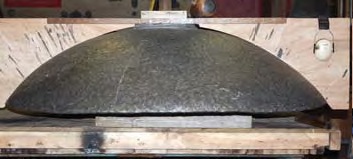
The next step was to weld 12 supporting ribs made from 10mm cast sheet to the inside of the outer bowl.
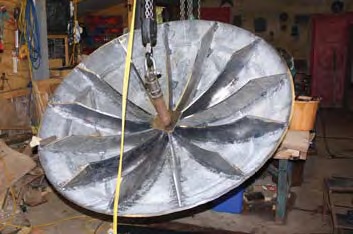
After finishing the outer bowl, Brian then set about the inner bowl in exactly the same fashion.
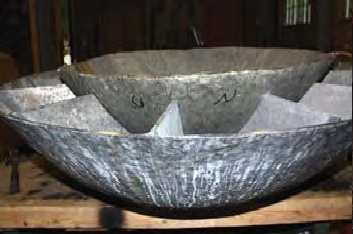
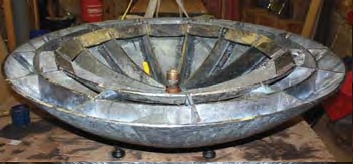
The inner bowl was then set onto the supporting ribs of the outer bowl, with great care needed to check that the bowls were level.
Next was putting the hammered effect finish to the pieces to be welded together to form the circular shelf section. These were then tacked onto the supporting ribs and then welded inside the circumference of the outer bowl and to the outside circumference of the inner bowl.
Having completed the first chalice, Brian then started all over again for the second chalice.
The bossing work to shape the inner and outer bowls took a total of FOUR DAYS for each of the chalices and Brian used a gas burner underneath continuously throughout the process to assist in the workability of the lead.
The finished effect is a stunning tribute to the skills of a dedicated craftsman. However, those that might casually admire the finished result in situ would have no concept of the sublime craft work and sheer physical effort required to create this work of art.
Would anyone ask themselves “How on Earth did he do that?” Find out more by emailing Brian at This email address is being protected from spambots. You need JavaScript enabled to view it.












